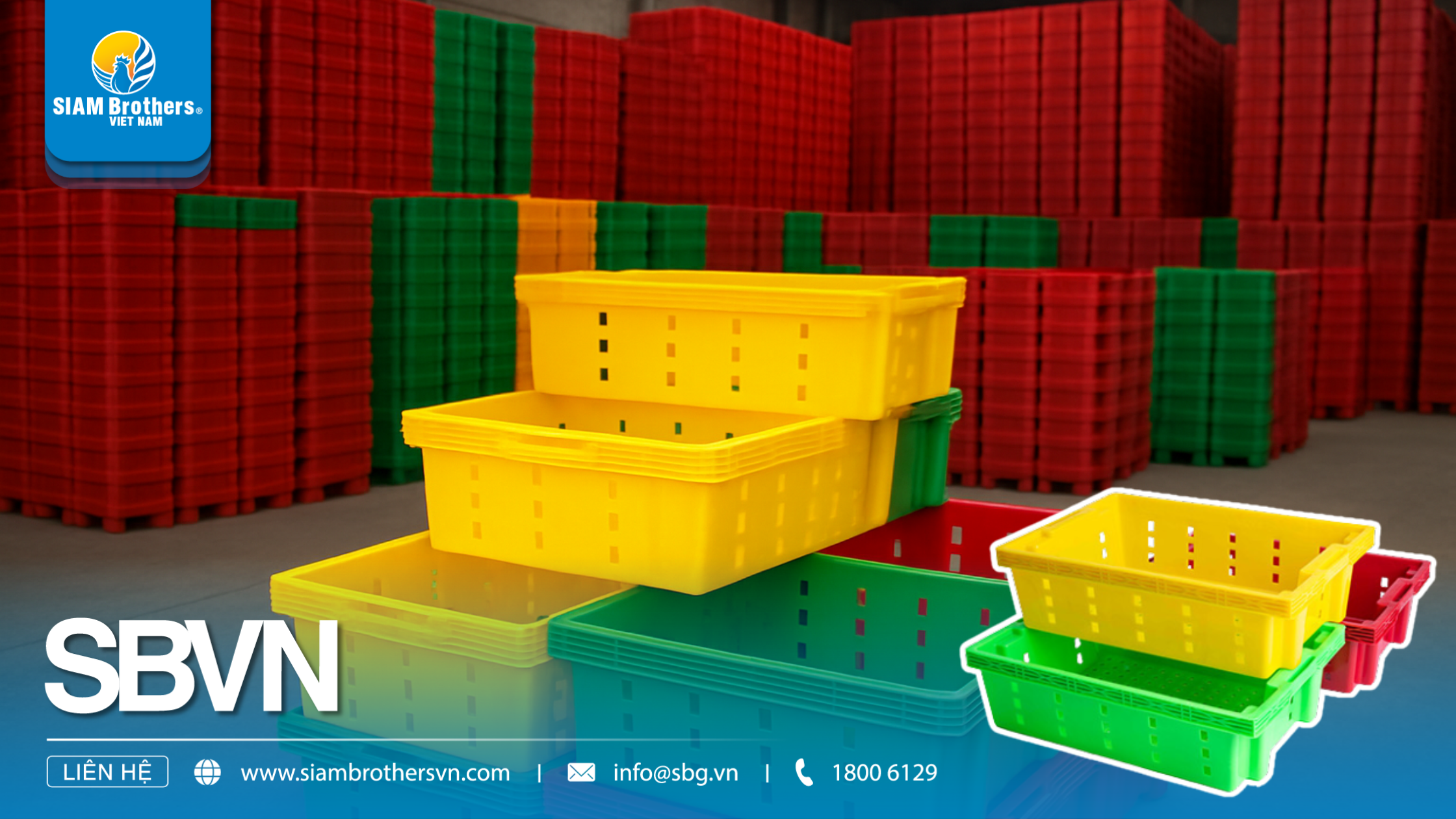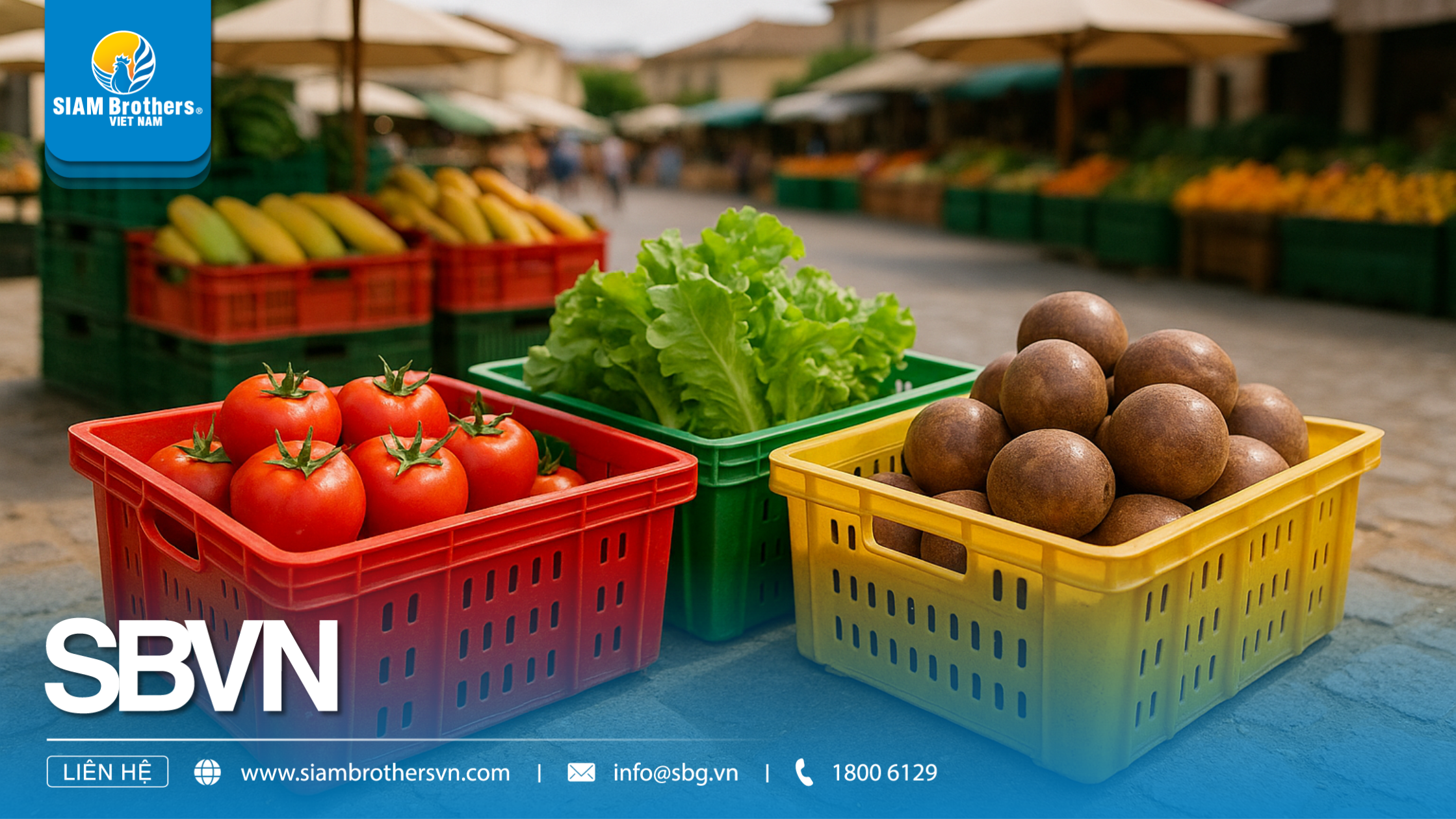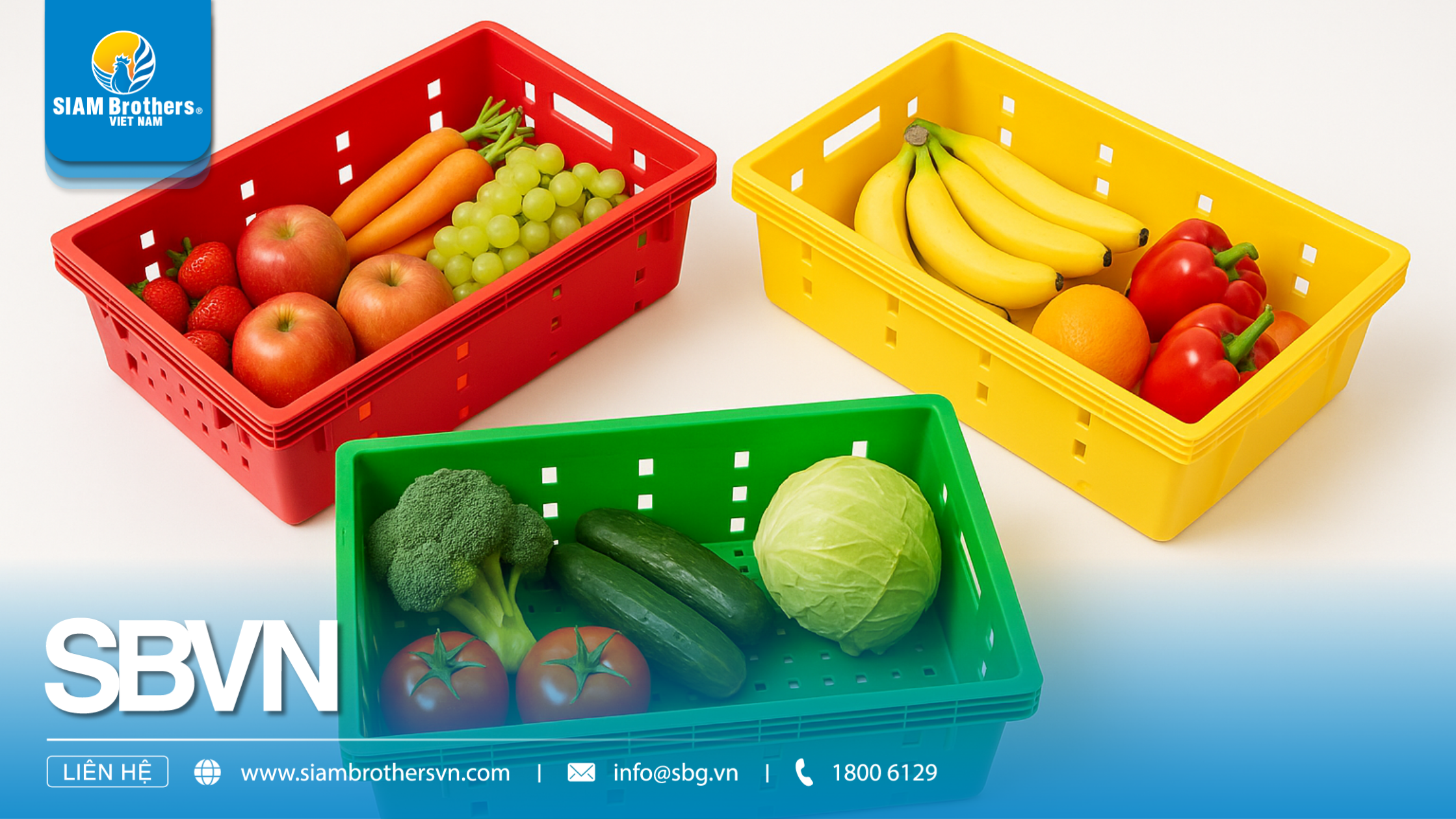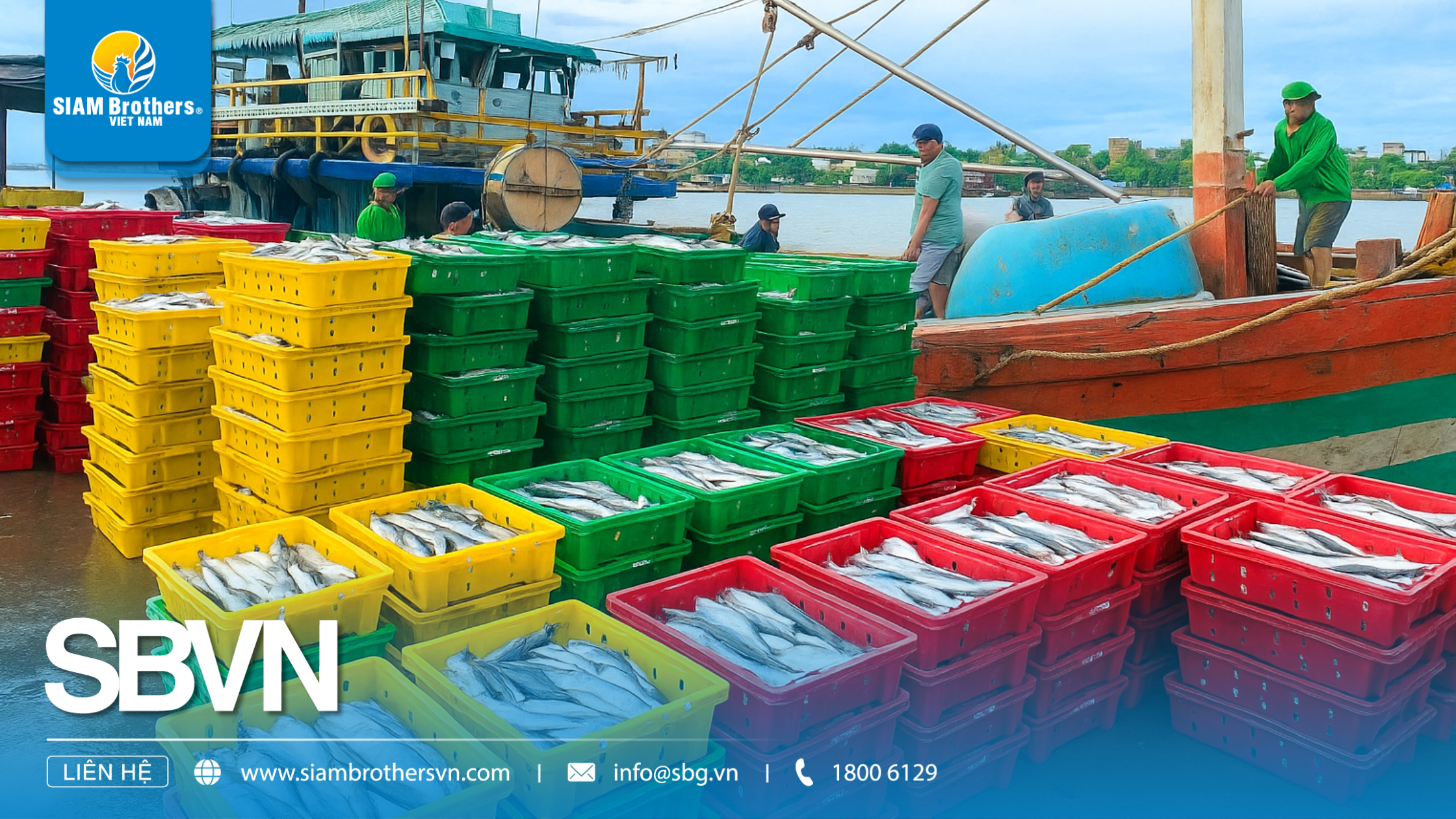If you’re searching for a tray that is both durable and environmentally friendly, an HDPE plastic tray is the ideal solution. This product is not only popular in agriculture and aquaculture but is also becoming the new standard in food transportation and storage industries. So, what exactly is this type of tray? Let’s explore with SIAM Brothers Vietnam below.
1. What Is an HDPE Plastic Tray?
HDPE (High-Density Polyethylene) is a high-density virgin plastic widely used in the production of food packaging, water containers, chemical tanks, and especially in industrial products such as HDPE plastic trays.

1.1 Key Characteristics of HDPE
- Excellent load-bearing capacity with minimal deformation under heavy weight.
- Heat-resistant and chemically resistant, suitable for harsh environments such as factories, cold storage, and aquaculture farms.
- Food-safe material, free from BPA and toxic substances.
1.2 HDPE Plastic Tray – Structure and Main Features
HDPE plastic trays are manufactured from 100% virgin HDPE resin or may be reinforced with additives for extra rigidity. Key features include:
- Thick, rigid tray walls: Prevents warping or denting when stacking or transporting heavy goods.
- Smooth, easy-to-clean surface: Minimizes dirt buildup, ideal for storing seafood or fresh food in hygiene-sensitive environments.
- UV- and chemical-resistant: Can be used outdoors without becoming brittle or discolored under sunlight or exposure to mild chemicals.
- Smart design options: Some models include raised feet, drainage holes, or ergonomic handles for enhanced usability and storage efficiency.
1.3 Common Applications of HDPE Plastic Trays
Today, HDPE plastic trays are widely used across various industries, including:
- Aquaculture: Holding fish, shrimp, clams during processing, storage, and transport.
- Agriculture: For seedling trays, vegetable harvesting, and produce classification.
- Food and logistics: Used in frozen food storage and export packaging chains.
- Supporting industries: Containing components and semi-finished products in factories.
2. Outstanding Advantages of HDPE Plastic Trays
2.1 High Load Capacity – Built to Last
- Withstands heavy loads without bending or cracking.
- Ideal for stacking, long-distance transport, and extended warehouse storage.
- Reduces damage risk for sensitive goods like fresh seafood or heavy agricultural produce.
- Resistant to mild acids, saltwater, and common industrial solvents.
- Can be used outdoors or in cold storage without becoming brittle or faded.
- A reliable solution for environments with fluctuating temperatures or high humidity.
2.3 Food Safety – Free from Harmful Substances
- Made from virgin HDPE resin, free from impurities and BPA.
- Ensures maximum safety when in direct contact with food.
- Preferred in clean food supply chains and seafood export processes.

2.4 Easy to Clean – Reusable for Multiple Cycles
- Smooth surface limits dirt accumulation and allows quick cleaning with water or mild detergents.
- Maintains shape even after repeated use—more cost-effective than disposable trays or poor-quality recycled plastics.
2.5 Versatile Design – Adaptable to Various Needs
- Customizable with feet, drainage holes, handles, and lids for specific uses.
- Stackable and compatible with carts or forklifts, improving storage and logistics operations.
- Choosing high-quality HDPE plastic trays reflects not just efficiency but environmental responsibility.
- HDPE is fully recyclable—helping reduce plastic waste and supporting businesses aligned with sustainable production trends.
3. Comparison Between HDPE Plastic Trays and Common Types of Trays
| Criteria |
HDPE Plastic Tray |
Recycled Plastic Tray |
Stainless Steel Tray |
Metal Tray |
| Durability & Load Capacity |
Very high – resists deformation even when stacked |
Low – easily cracked or broken under impact |
High – sturdy but heavy |
Medium – prone to dents under pressure |
| Weight & Flexibility |
Lightweight – easy to handle and stack |
Lightweight but lacks structural integrity |
Heavy – difficult to maneuver |
Heavy – not ideal for mobile applications |
| Corrosion & Chemical Resistance |
Excellent – resistant to salt, mild chemicals, and UV rays |
Poor – degrades quickly when exposed to chemicals or sun |
Good – rust-resistant |
Poor – easily rusts, especially in marine environments |
| Food Safety |
Yes – made from virgin HDPE, toxin-free |
No – possible contamination from mixed materials |
Yes – safe for use in food industry |
No – not suitable for food contact |
| Cost |
Reasonable – cost-effective over long-term use |
Cheap – but low durability |
High – significant initial investment |
Medium – higher maintenance/replacement costs |
| Reusability |
High – long-lasting and easy to clean |
Low – degrades after limited use |
High – retains quality over time |
Medium – prone to rust if not maintained properly |
Which Tray Should You Choose?
The right tray depends on your usage needs, budget, and safety standards. But if you are looking for a solution that is:
- Durable,
- User-friendly,
- Hygienic and environmentally friendly,
then an HDPE plastic tray is the most efficient choice for your storage and transport requirements across various industries.
4. Frequently Asked Questions About HDPE Plastic Trays
4.1 Are HDPE plastic trays safe for storing fresh food?
Absolutely. HDPE plastic trays are made from virgin HDPE resin, free from BPA and harmful chemicals. They meet international food safety standards and are ideal for storing seafood, vegetables, and fresh meat in cold storage or transport systems.
4.2 Are HDPE plastic trays easy to clean and reusable?
Yes. With a smooth, non-absorbent surface, HDPE plastic trays can be easily washed using regular water or industrial cleaning agents. They do not retain odors or stains, making them suitable for repeated use without compromising quality.
4.3 Are HDPE plastic trays more expensive than other tray types?
While the initial investment in HDPE trays may be higher than recycled or low-quality plastic trays, their durability, reusability, and safety make them more cost-effective in the long run.
4.4 Who should use HDPE plastic trays?
HDPE plastic trays are recommended for:
- Aquaculture farms: For harvesting, storing, and transporting shrimp, fish, clams, etc.
- Agricultural and seafood processing facilities: Especially in humid, cold, or chemical-exposed environments.
- Export businesses: Requiring food-safe, durable trays for long-distance shipping.
- Organic farms and vegetable gardens: For seedling cultivation and produce sorting.
- Factories and industrial workshops: For storing parts, materials, and semi-finished products.
- Whether you're an individual or a business with high-volume, demanding storage or transportation needs, HDPE plastic trays are the optimal solution.
4.5 Where can you buy high-quality HDPE plastic trays?
SIAM Brothers Vietnam is one of the leading manufacturers and distributors of genuine HDPE plastic trays, trusted by hundreds of partners in aquaculture, agriculture, and industrial sectors.
When purchasing from SIAM Brothers, you’ll receive:
- Products that meet international food safety standards, made from 100% virgin HDPE.
- Wholesale pricing and support for bulk orders.
- Tailored technical consultation, with tray designs adapted to your actual usage needs.
- Nationwide delivery, fast and reliable.
Thanks to their exceptional load capacity, corrosion resistance, eco-friendliness, and hygiene compliance, HDPE plastic trays are rapidly replacing traditional tray types in aquaculture, agriculture, logistics, and food processing industries.
Whether you're a manufacturer, distributor, or exporter, investing in high-quality HDPE plastic trays is a strategic move to optimize operations and elevate your brand’s image.
Looking for a durable and long-lasting tray solution?
Contact SIAM Brothers Vietnam today to get the best HDPE plastic tray quote, expert consultation, and premium product experience.
Source: SIAM Brothers Vietnam
Contact us:
Address: 5th floor, VRG Building, 177 Hai Ba Trung Street., Vo Thi Sau Ward, District. 12, Ho Chi Minh City, Vietnam
Tel: (+84) 28 38 912 889
Hotline: 1800 6129
Facebook: www.facebook.com/siambrothersvn
Email: info@sbg.vn
YouTube: youtube.com/@siambrothersvietnam1728
X: x.com/sbvnjsc
OA Zalo: zalo.me/1402339229697925373
App SBVN ID:





